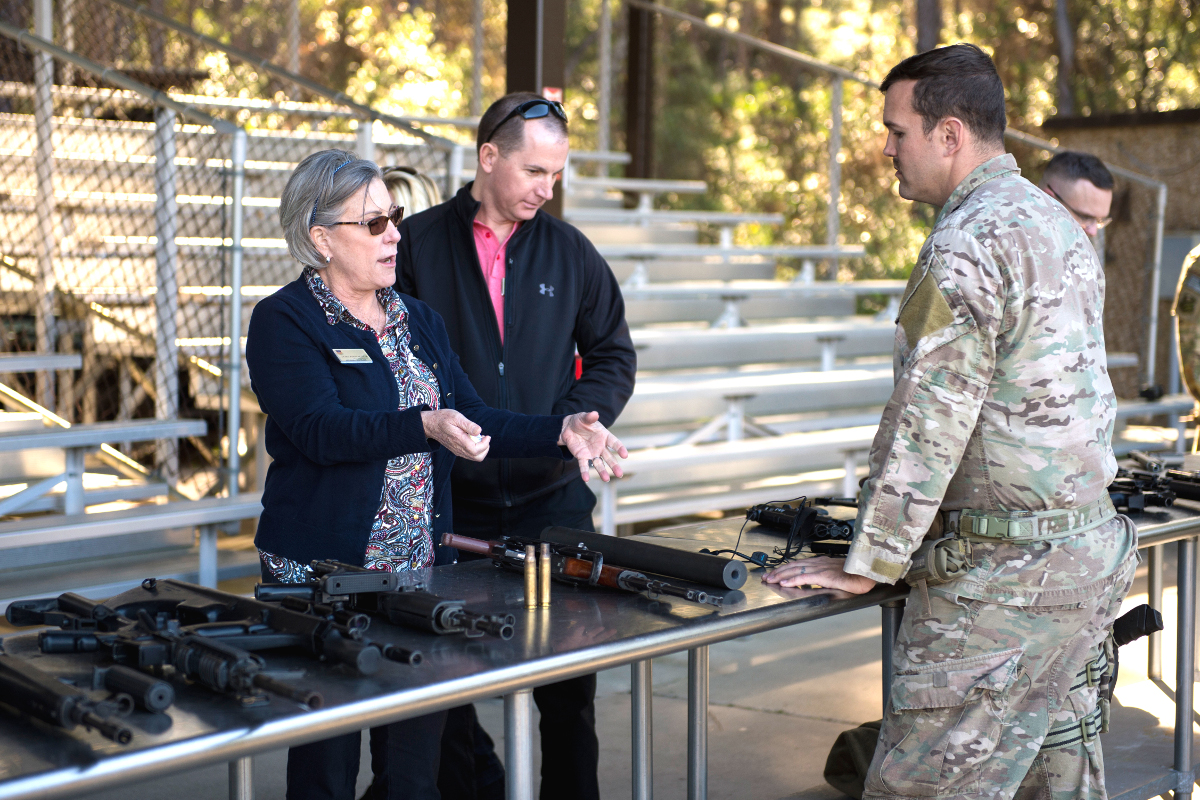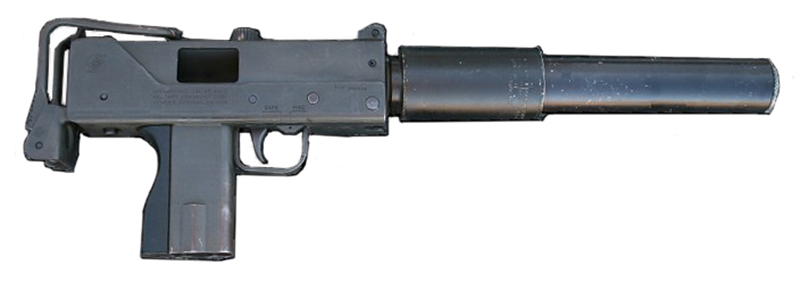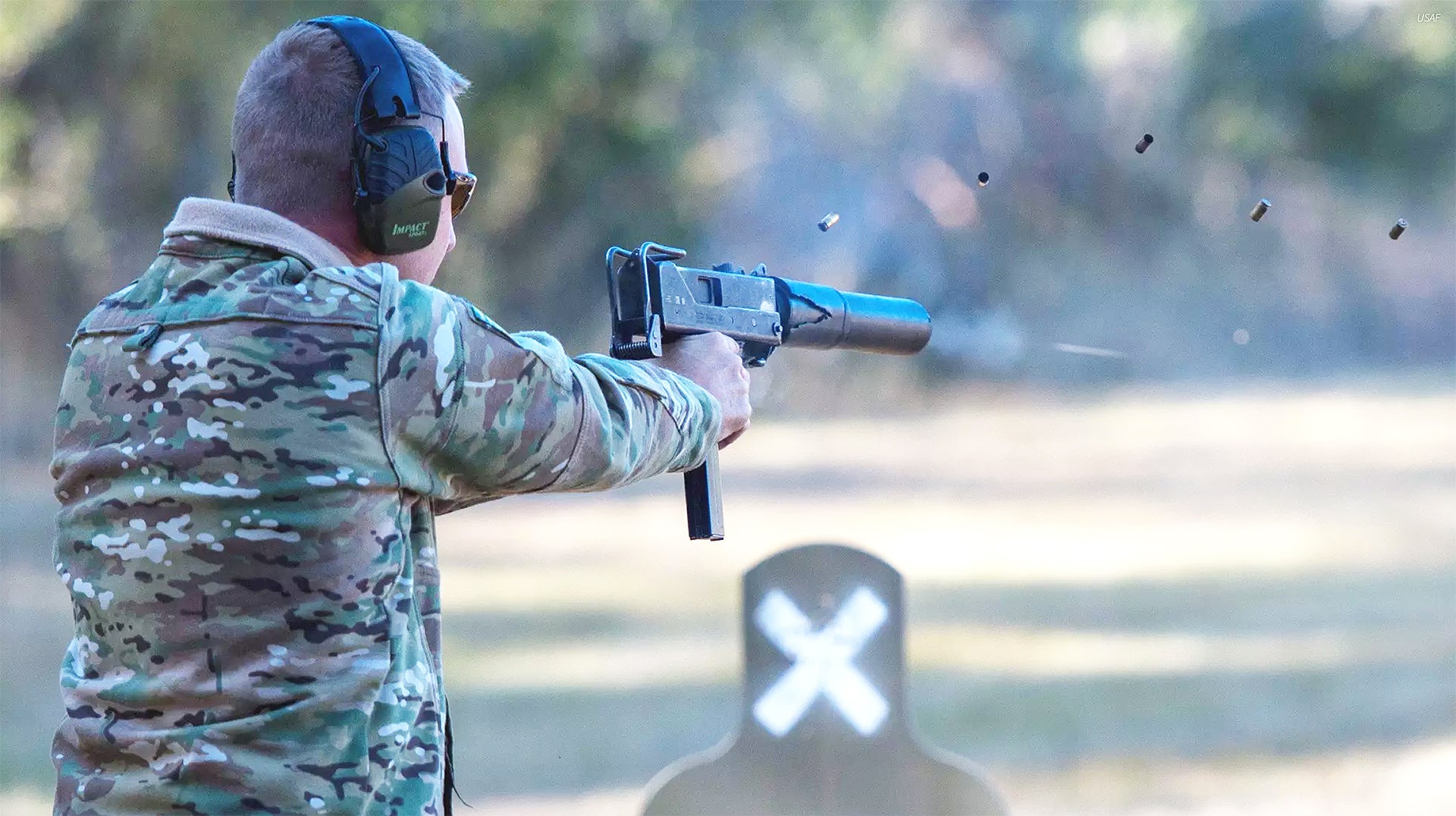The Military Armament Corporation Model 10 submachine gun, better known as the MAC-10, is an iconic gun, but one that many people are likely to associate with criminals and Hollywood movies. Its designer, Gordon Ingram, and his business partner Mitchell WerBell III, had originally hoped it would become an essential tool for special operations forces, covert operatives, and law enforcement – and apparently some are still sitting in U.S. military armories.
On Dec. 13, 2017, members of the U.S. Air Force’s 492nd Special Operations Wing held a meet-and-greet and tour for civilians at Hurlburt Field in Florida. There was even a firepower demonstration and the unit brought out an array of American and foreign firearms, including a well-worn MAC-10 with a sound suppressor. Other unusual weapons on display included a folding stock variant of the ubiquitous Kalashnikov AK assault rifle, an Israeli Galil SAR carbine, and an Austrian Steyr AUG assault rifle.
The 492nd helps train members of the Air Force Special Operations Command (AFSOC), test aircraft, and develop new special operations tactics and techniques. Until May 2017, the unit had been known as the Air Force Special Operations Air Warfare Center, or AFSOAWC.
Like other special operations elements in the U.S. military, AFSOC personnel familiarize themselves with various uncommon and foreign weapons that they might encounter in the field, especially while training friendly troops overseas. As such, it’s not surprising that the Wing has older and more obscure weapons on hand.

Official photos from the event show a member of the 492nd hosing down various reactive targets, including containers of water and one that burst into flame, with the diminutive MAC-10. The target range also included a dummy sitting on a mock bus stop bench with a bottle of “booze” in paper bag.
It’s a setup that plays more to the popular conception of the gun as a sidearm of bank robbers, drug dealers, gang members, and other criminals, which certainly became true in the 1970s and 1980s. At the same time, movies and television shows further popularized the MAC-10 and its derivatives as the weapon of choice for criminals and terrorists and anti-hero cops and mercenaries alike.

At less than a foot long with its wire stock folded up and less than seven pounds empty, the small guns were easy to carry concealed. They might not have been particularly accurate, but firing more than 1,000 rounds per minute, they could lay down a hail of fire in a confined space. With that rate of fire, a shooter could expend the gun’s magazine – with 30 rounds in the .45 caliber version and 32 in the 9mm variant – in seconds, though.
But these same attributes that made them attractive to criminals were the ones Ingram and WerBell thought would make them ideal for counter-insurgency and counter-terrorism type missions, as well as for police duties and VIP protection details. The U.S. military’s interest in such weapons, during the Vietnam War in particular, is quite possibly how it came to be in possession of the 492nd’s MAC-10 in the first place.
In the 1950s, Ingram had set up his own firm, Police Ordnance Company, selling in part weapons of his own design. His .45 caliber Model 6, which looks similar to the legendary Thompson submachine gun, achieved at best moderate success with law enforcement organizations and he found little interest in his subsequent designs in the United States or abroad.

In 1964, he crafted his first prototype Model 10 in .45 caliber. The next year he made a second prototype in 9mm. He found no takers for his newest guns and shelved the project, moving on to take an engineering job with aviation firm Fairchild-Hiller.
During the same period, WerBell had been working separately developing sound suppressors and other specialized weapons for elite U.S. military units and government groups focusing on covert and clandestine activities, such as the Central Intelligence Agency. His company, Studies in the Operational Negation of Insurgents and Counter-Subversion, or SIONICS, built suppressors for the M14 and M16 rifles that went to special operations elements fighting in Southeast Asia.
WerBell, a veteran of the Office of Strategic Services during World War II, the precursor organization to the CIA, and professional mercenary later in life felt a Model 10 with one of his suppressors would be well suited to discreet operations. Typical .45 caliber loads propel the bullet at subsonic speeds, which already eliminates the usual sharp crack that would come from the bullet breaking the sound barrier.

He offered Ingram a partnership deal, which eventually morphed into a new company called Military Armament Corporation (MAC) in 1970. The firm subsequently rebranded the guns as MAC-10s and offered a smaller .380 caliber version called the MAC-11.
With connections to the CIA and the U.S. special operations communities, and by extension to similar foreign military and intelligence organizations, WerBell became the gun’s primary pitchman. He toured all over, but especially in Southeast Asia demonstrating MAC-10s for American, South Vietnamese, and Thai military personnel, among others. WerBell was so eager to show off the gun, Ingram had to design quick craft an initial batch of suppressors to go along with the guns for the initial trips, according to one article from Small Arms Review.
WerBell did eventually develop a SIONICS unit specifically for the MAC-10 that featured two distinct chambers that would bleed off propellant gasses, reducing noise from firing and eliminating any muzzle flash. It also served as an easy way to hold the gun steady, but quickly became too hot for shooters to hold with their bare hands, leading to the further addition of Nomex cover.
U.S. Army Special Forces and the U.S. Navy SEALs and Underwater Demolition Teams (UDT) did purchase small numbers of the guns, along with a host of other submachine guns and compact rifles. The SEALs and UDTs still had the guns in their armories at least until 1982, when the Navy merged the two organizations together.
In April 2016, the Naval Surface Warfare Center in Crane, Indiana said “Cats and Dogs” – a reference to small numbers of various non-standard guns – were among the rifles and submachine guns still in Navy arsenals in a official briefing describing plans to consolidate that inventory. The same is likely true of arms lockers throughout the special operations community and even among some regular units, especially in the Air Force, where small arms are generally not a priority.

The MAC-10s appeared in the arsenals of similar units around the world, too, but never in large numbers. The Israelis did use them in lieu of their own Uzi submachine guns during the famous raid to liberate hostages at Entebbe airport in Uganda in 1976.
Law enforcement officials were dismissive of the MAC-10. “I didn’t think the MAC-10 and -11 were up to police requirements for either accuracy or burst control,” David Steele, who served for a time a weapons researcher for the International Association of Police Chiefs, wrote in The Gun Digest Book of Assault Weapons, first published in 1986. “I thought both MAC models were fit only for combat in a phone booth.”
The gun made its big break in Hollywood in the hands of John Wayne’s titular main character in the movie McQ, with the weapon being a prominent feature in the marketing material for the film, but it wasn’t enough. Infighting within the company had pushed out both Ingram and WerBell, according to another Small Arms Review article. By 1975, MAC filed for bankruptcy. The end of the Vietnam War and the U.S. military’s shift away from guerrilla warfare, special operations, and counter-insurgency couldn’t have helped matters any.

A succession of companies purchased the rights to build the submachine guns, but there continued to be only limited interest among military and law enforcement groups. As already noted, it became increasingly common to find them in the hands of criminals and terrorists and the MAC-10 became in many ways synonymous with crime in the 1980s.
Any success on the civilian market was initially cut short by the 1984 Firearm Owners Protection Act, which banned the sale of new production machine guns to private citizens, immediately leading to a surge in the price of existing weapons that the law grandfathered in and making them prohibitively expensive.
Companies still make semi-automatic derivatives and there are still a number of fully-automatic versions that individuals can legally purchase, all depending on local laws and ordnances. But the guns are mainly popular among civilians for competitive shooting and as a sort of cult classic among firearms collectors, given both their history as a special operations weapon and their more recent associations.
For the 492nd, its MAC-10 appears to be equally more for show than anything else at this point. However, there is growing interest among special operations forces in more compact firepower once again.
Contact the author: joe@thedrive.com
